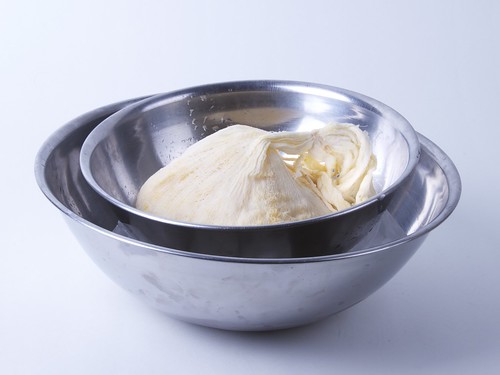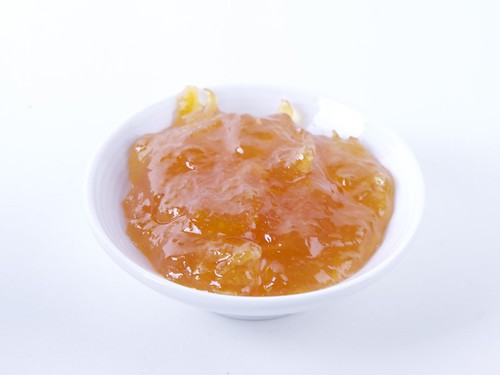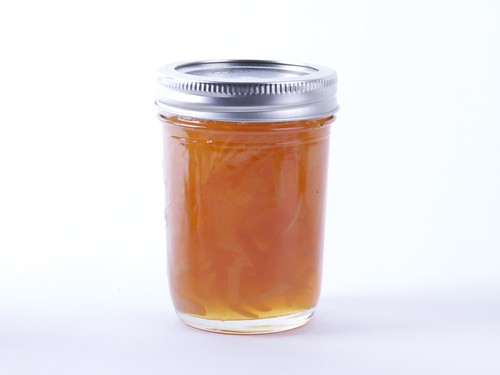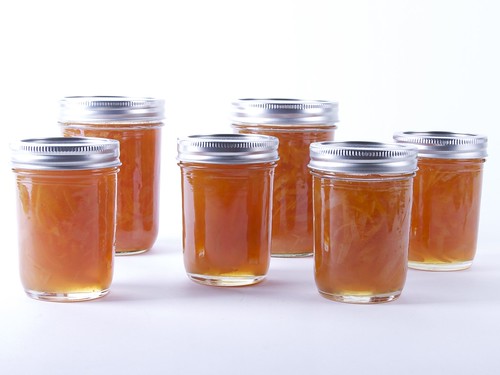It’s lemon season again, and that means more marmalade! Last year we showed how incredibly easy it is to make a simple marmalade. That kind was more of the bitter, opaque variety–which might be your favorite–but here’s how to take that to the next step and make a light and sweet marmalade. Last time, we did it the easy way–cutting everything up and throwing it in a pot. This time, we’re using out a slightly more traditional technique. We’re starting with a seville orange marmalade recipe that is remarkably similar to our earlier recipe, at least in terms of ingredients: fruit, water and sugar. By straining the pulp out and keeping the pith separate, we can make a much more transparent preserve. We still need those parts for producing pectin, so they get tied up in cheesecloth for the first part of the cooking. As before, first peel the fruit and cut the peel into slices. You can soak them for several hours in water or blanch them to help remove bitterness if you like. Next, juice the fruit and set aside the pithy and pulpy parts. Strain the juice through a couple of layers of cheesecloth, and then tie up all the pith and pulp in the cheesecloth. Then put the strained juice and peel in a pot with the bag of pith, cover with water, and boil until the peel gets nice and soft.

Remove the pith bag and put it in the cold equivalent of a double boiler: a bowl on top of a layer of ice that’s in a larger bowl. Turn the bag over every so often to help it cool down more quickly. When it is cool enough to handle, squeeze out a few tablespoons of the cooked pulp and pith through the cheesecloth–this will provide the pectin that will help the marmalade to gel.

Put the pectin goo into the pot (which you conveniently left simmering on the stove) and add your sugar. Stir regularly and cook to the desired consistency. And that’s it, you’re done. You can, of course, can the finished product, or you can just spoon it into a bowl and serve it.

The extra step of separating and straining the pectin is a little more work, but it makes for a stunningly beautiful marmalade. The stuff just glows in the jar. It is darned tasty, and the consistency of the peel is very nice. It doesn’t have the same depth of flavor and bitter bite that you get from keeping all of the bits of pulp and peel in. It is much more like a store-bought sweet marmalade (and not the corn syrup kind!) than like the bitter marmalade we made before. Our taste tests so far confirm that this is a real crowd pleaser. Another variation we had success with was lemon-ginger, which our commenters had suggested. Grate a big chunk of peeled ginger into the pot with the fruit pieces, and get a nice flavor kick. If you’re inspired to make some, or come up with new variations, we’d love to hear about it, and we love seeing your pictures in the Evil Mad Science Auxiliary flickr pool.





I’m going to try this again. After last year’s experient I ended up with a huge jar of orange flavoured glue. It was very tasty but I made a bit too much and probably added too much sugar.
Do I need to buy special jam making sugar that contains extra pectin, or is there enough in the oranges themselves? And if I’m canning the stuff afterwards do I need to boil the jars, or is it enough to just screw the lids on?
If you are going to store your jam for any length of time, you will need to boil your jars and lids.
<insert excerpt from Good Eats>
Preserving the jam: Thoroughly wash all hardware in hot soapy water. Then pile everything (excluding the jar lids) into the pot. Cover with hot water by at least 1-inch and bring to a boil and maintain for 10 full minutes to sterilize. Turn off the heat, wait 5 minutes then add the lids (waiting will insure that the sealing compound does not melt). Leave all hardware in the pot until you’re ready to can.
http://tinyurl.com/29etjzv — Full recipe these notes came from.
There is a lot of pectin in the pith, pulp, and seeds of citrus fruits, which is why you typically don’t need to add pectin to marmalade recipes. You shouldn’t need any special sugar, either. You can always try decreasing the amount of sugar you use if you don’t want your marmalade to be as sweet. Most oranges are sweeter to begin with, so you might also try adding some lemons or grapefruit if you want more tartness.
There are lots of schools of thought on canning, and I’m not an expert. I do boil my jars first, and then after putting the lids on, I boil the full jars for 15 minutes. In last year’s article, I linked to the Ball Jar people’s overview of canning, which has more techniques you might find helpful.
Thanks for the recipe! But is it for lemons or oranges? Does it matter?
You can make marmalade with pretty much any citrus fruit. The marmalade pictured here is lemon, but it should work for just about any combination of citrus, including orange. I like to add some lemon when I’m making orange marmalade to give it a little more zip.
Sounds like a nice recipe, got to try it sometime.
And how exactly did you make that gorgeous last picture of the marmalade jar?
What lighting did you use to produce that nice glow in the background?
It’s a little bit backlit–our two diffused strobe flashes were aimed slightly behind the jar, one from each side. If you look at the seville marmalade recipe linked above, you’ll see a similar effect with natural backlighting–the jar is placed on a windowsill so that the sunlight will shine through. Unfortunately, I didn’t have any sunlight to work with.
what a lovely color you have there!
i love marmalade, having grown up on it in a Commonwealth nation. read an article recently where someone mentioned how easy it was to make it at home – thus eventually i landed up on your site. glad to have done so!
so anyway, i made my first jar of marmalade today! based on your older recipe sans cheesecloth. used 2 regular oranges and a lemon – came out nice and bitter, just as i like it! its also a bit deeper orange in color – i’m thinking its coz of the brown unrefined sugar i used instead of white. but all in all, it was a good time making it, and will enjoy it for a while.
i’m now motivated to buy me some cheesecloth… looking forward to making my next batch per your new recipe. thanks :)!!
I’m never going to find an easy marmalade recipe using fruit concentrate instead of sugar which would be so much better for ones health. The French have come up with one which is expensive to buy commercially but I am hooked on it.
Anything else is far too sweet now. Perhaps a mad scientist could produce this marmalade. However, sweet not seville oranges might have to be used.
Roll on 2012 – maybe you will produce this as your new recipe then.
Meanwhile I’m using your 2010 recipe for my Seville oranges, pith and all. I have loads and I’m sure the result will not be too sweet.
I am making the crap out of some kumquat marmalade as soon as I can get my hands on some kumquats. It is like orange marmalade but tastier, and I love me some orange marmalade.
Would this be able to be varied with diffrent citrus combos, etc. Orange and Lime? Or would Lime have enough pectin in it to make the marmalade set up?